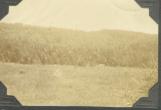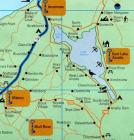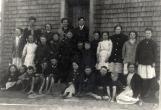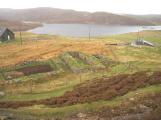14
As Cape Breton was returned to the governance of Nova Scotia in 1820, increasing numbers of people heard about the good land adjacent to the lake and the availability of land grants, mostly by word of mouth. With very few exceptions (such as the Hamiltons from the Lowlands of Scotland) the incoming settlers were Gaelic-speaking from the various islands off the west coast of Scotland and from the adjacent sections of mainland Scotland.15
View of East Lake Ainslie showing the division of property by rows of bushes or trees.2003
East Lake Ainslie

16
They often came in extended family groups, sometimes from Prince Edward Island across the Gulf of St. Lawrence and sometimes from Pictou on mainland Nova Scotia, and some having disembarked on Cape Breton soil directly from Scotland, these MacDonalds and MacIsaacs, MacLeans and Campbells, MacKinnons and MacCormacks, MacDougalls and MacQueens, Dunbars and Walkers, MacPhails and MacMillans and others, applied for and were granted lots of land extending from the shoreline to rear surveyed lands on the hillsides with 100 or 200 acres assigned, a quarter of a mile wide and nearly a mile deep.18
As people who had lived for time immemorial in Scotland on lands owned by clan chieftainsand hugely powerful regional overlords, the immigrants were gratified to find that they could
own their own land and plot their own futures.
19
Picture showing the density of the forests that the settlers faced upon arrival at Lake Ainslie.1955
East Lake Ainslie

20
The learning curve in the first twenty years was very steep: a much harsher climate with longer winters and deeper frost than they were accustomed to; new plants to be understood as being helpful to heal people or dangerous if consumed; many, many trees (only remnants of the old forests remain deep in the interior today) which provided a new kind of shelter (wooden houses) and fuel for cooking and warmth as compared to peat in the "old country", and sweetening for tea by boiling the maple sap to make sugar and syrup.But people were free to fish where they wished, hunt as they could; plough and plant where and what seemed best - an entirely new kind of economy and way of life. Huge tracts of land were cleared of woods and log houses were built - and even log schools constructed within the first decade and a half.
22
Almost as though planned, the lake provided a separation between the two major Christian denominations. The Roman Catholics lived on the western side and some of the northern end or Kenloch (head of the lake in Gaelic) while the eastern, northeastern and southern portions of the land were almost entirely Presbyterian.The people were united, however, by their common Gaelic culture of language and song and by a long tradition of hospitality and caring for one another. The sharing of work to build barns to shelter animals and to construct grinding mills for the grain (oats, wheat, barley, and buckwheat) brought people together.
23
Lake Ainslie, shown with detail of local area. The Blue Key symbol denotes a museum.13 November 2003
Lake Ainslie

24
Little by little place names began to be assigned mostly by common practice - East Lake and West Lake, North Lake and South Lake; head of the Lake in English at one end (the southern part) and Kenloch (head of the lake in Gaelic) at the other end; then Twin Rock Valley for a geographical formation and Glenmore for "the big glen"; the Outlet for the place where the lake began it's long journey to the sea (later to be known as Scotsville); Trout River for it's ample supply of fish; and so on.25
Photo of the class from Hamilton School section around the turn of the century.1910
Hamilton, Lake Ainslie



